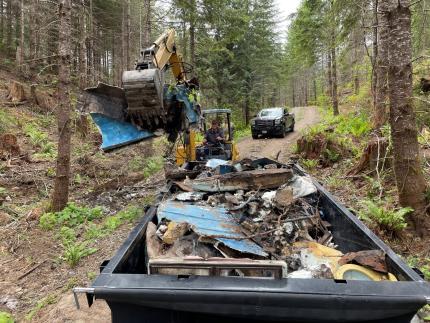Managing Wildlife Populations
Sooty Grouse Surveys: Region 4 district wildlife biologists completed the first year of surveys for sooty grouse using a protocol developed by Oregon State University and Oregon Department of Fish and Wildlife. Biologists will conduct listening surveys for male sooty grouse along predetermined routes each year from April into May. By listening for the distinctive calls of male sooty grouse, biologists can assess trends in abundance of grouse over time.

Protected State Wildlife -Peregrine Falcon Climbing Closure in King County: District 12 Biologists Anderson and Smith spent some survey time in the field with volunteers from Urban Raptor Conservancy (URC). A very dedicated member of the URC has been keeping weekly tabs on a very popular King County climbing wall to monitor age and stage of young peregrine falcons. The four eyasses (chicks) should be fledging in the next two weeks. We thank the URC for their extra eyes and survey efforts as it really assists in providing a detailed tab on this and other falcon sites that are under pressure in King County. Appreciation also is extended to the broader climbing community, Washington Climber’s Coalition, State Parks, US Forest Service, and others for support and collaboration in nesting management efforts.

Washington Bat Working Group: There is a new working group that is a subcommittee of the Washington Bat Working Group. They will be examining bat box designs, efforts, outreach, research, and all things related to bat boxes. Biologist Anderson participated in the inaugural meeting.
Washington State Department of Transportation (WSDOT)-Habitat-Wildlife Program Culvert Replacement – Wildlife Considerations: District 12 Biologist Anderson and Waterfowl Biologist Hamer met with WDFW Habitat and WSDOT environmental leads regarding a project in the Grotto area of King County. At this site harlequin ducks, a species of greatest conservation need (SGCN) as outlined in the State Wildlife Action Plan (SWAP), had a history of breeding season loafing and nesting at the site. The project and site were discussed specifically and visited. Due diligence surveys were conducted by the Habitat Program and WSDOT worked on implementation of the culvert replacement. The highlight was discussing consideration of harlequins and other SGCN in relation to other culvert/alteration of waterway projects, such as culvert replacement efforts, moving forward.
Providing Recreation Opportunities
The Region 4 Private Lands Access Program has spent several days this month partnering with Sierra Pacific Industries to remove dumped garbage from properties. Sierra Pacific Industries provides extensive recreational access to general public and additional access for special permit hunters and hunters who access their property through the Hunt by Reservation System. Garbage cleanups are a way to reduce the challenges that come with public access and encourage private timber companies to continue to allow public access. Some of these cleanups can be done by hand, but other require extensive planning and equipment.





The Region 4 Private Lands Access Program (PLAP) team recently finished planting the Bayview-Edison north and south hunt sites. PLAP has contracted with the landowner to lease 80 acres for waterfowl forage. This property was planted in pasture grass last fall. Over the winter, the sheet water built up and flooded out several zones and waterfowl foraged heavily on the growing grass. This spring in the flooded-out zones, the PLAP team prepared the ground and planted a mix of forage crops for wintering waterfowl that will increase the diversity of food resources on this property and provide more forage for waterfowl. The property is managed for hunting access as well. Washington Migratory Bird Stamp funds were used for this project.
Conserving Natural Landscapes
Restoration Project Coordinator Desmul and Environmental Planner Ballhorn with the Habitat Program spent a sunny morning on Spencer Island in the Snoqualmie Wildlife Area downloading level logger data to measure water temperature, depth, and salinity. The data will be used to help plan a restoration project on site.

Providing Education and Outreach
Restoration Project Coordinator Desmul and Assistant Regional Wildlife Program Manager Brokaw led two tours of Leque Island in the Skagit Wildlife Area, one for the community group Sound Water Stewards from Island County and one for the Habitat Strategic Initiative.

